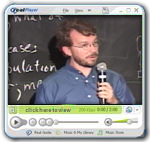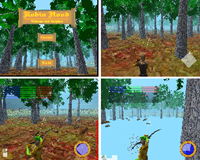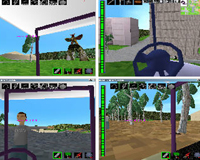Outgoing UCSD Seniors Develop Multiplayer, Online Videogames for Software Design Course
|
San Diego, CA, June 9, 2005 -- Computer science students don't usually draw a crowd of onlookers for their final exam. But the nearly three dozen seniors who took CSE 125 this quarter drew a standing-room-only crowd in Peterson Hall on June 3, as fellow students, faculty and bystanders packed the auditorium to watch - and even play - five online videogames created by the students from scratch.
"The course is called software system design and implementation, but most people call it 'the games course,'" says Geoffrey Voelker, the Calit2-affiliated faculty member who teaches the senior design course every spring. "The goal is to let students experience the design and implementation of a large, complex software system in large groups."
|
To make the class exciting as well as challenging, the project is a distributed, real-time, 3D, multiplayer game of each group's design. The course gave students a chance to show off all the skills they developed over the previous four years, with only a modicum of help from Jacobs School of Engineering computer science professor Voelker and his teaching assistants, Karen Hom and Allen Ding.
"These projects reflect the outstanding independence, initiative and problem-solving skills of the class," says Voelker, "You can think of it as the culmination of the curriculum they've taken in computer science and their personal achievements over the years. It's impressive to watch them come up with these amazing games in just ten weeks."
|
Like previous years, most of the games fell into the category of so-called 'first-person shooter' games, but with a twist. "We wanted something very dynamic, with very randomly generated levels," says Fred Lionetti, who worked on a Sherwood Forest-themed game, Robin Hood: Knights and Thieves . "But we didn't want a modern game, so we went for something a little older, with arrows. We even decided to have randomly generated trees and other objects, to make the game much more dynamic than many video games."
The team that created Campus Cart created a blend of first-person shooting and racing, with all the action set on the UCSD campus, with vivid graphics of landmarks including the Sun God sculpture. "Everybody else does shooter games, but we didn't want to do that, so we created a cart-racing game," says Andrew Song. "But then we decided itwould also be cool if we could also shoot at each other." Each cart represents a campus publication (UCSD Guardian, The Koala etc.) and the object of the game is to get as many readers as possible. Instead of shooting bullets, the player throws newspapers at potential readers, which change color when hit.
|
Voelker says this year's games showed even more creativity than usual, in part because most of this year's teams included a student from the Interdisciplinary Computing and the Arts Major (ICAM) program. "So rather than use existing models found on the web, the ICAM students did their own modeling, textures, and animation," explains Voelker.
"Initially we were overzealous in the type of game we wanted to make, but it only took about a week for reality to set in," says Frank Varela, who designed Animal Arena with his team-mates. "We decided to concentrate on the fun factor. All the graphics, the models, the sounds -- everything was done by us."
|
Upping the creativity quotient among this year's games: an airborne shoot-'em-up called Deathmatch Two (shorthand for the game's full name: Superschüle-Mädchen-Stadt Deathmatch Zwei ). The game features flying penguins that double as heat-seeking missiles; guns that shoot turkeys to create a gravity vortex; three-story-tall German killer schoolgirls; and oversized red rockets called CHMs (short for 'comically huge missiles').
The team that developed Robot Wars did not have an artist on board. "Unlike other groups we didn't have someone who is good at graphics, so we 'jacked a lot of stuff from the Internet," admits Eddie Shen. Instead, the team put all of its efforts into creating a multi-level shooter game with a variety of different types of weapons for each level, including maces for hand-to-hand combat on Level One and nuclear launch capabilities on Level Four.
|
Although each videogame is the team's final project, CSE 125 also emphasizes the development process itself. Over the course of ten weeks, the groups decided on the features of their projects, specified each game's requirements, created a design and implementation schedule, implemented it, and gave their public demonstrations. "Students are working in groups of six or seven people and that's an important lesson for the real world," says Voelker. "They solved all the problems themselves, including dealing with a complex software environment."
Several of this year's students had so much fun in the course that they would like to be able to design videogames for a living. That's nothing new, says Voelker. "Around 20 percent of the students in the class would like to get jobs in the game industry," he said. "Some of our previous years' graduates have already been working at game companies for two or more years."







